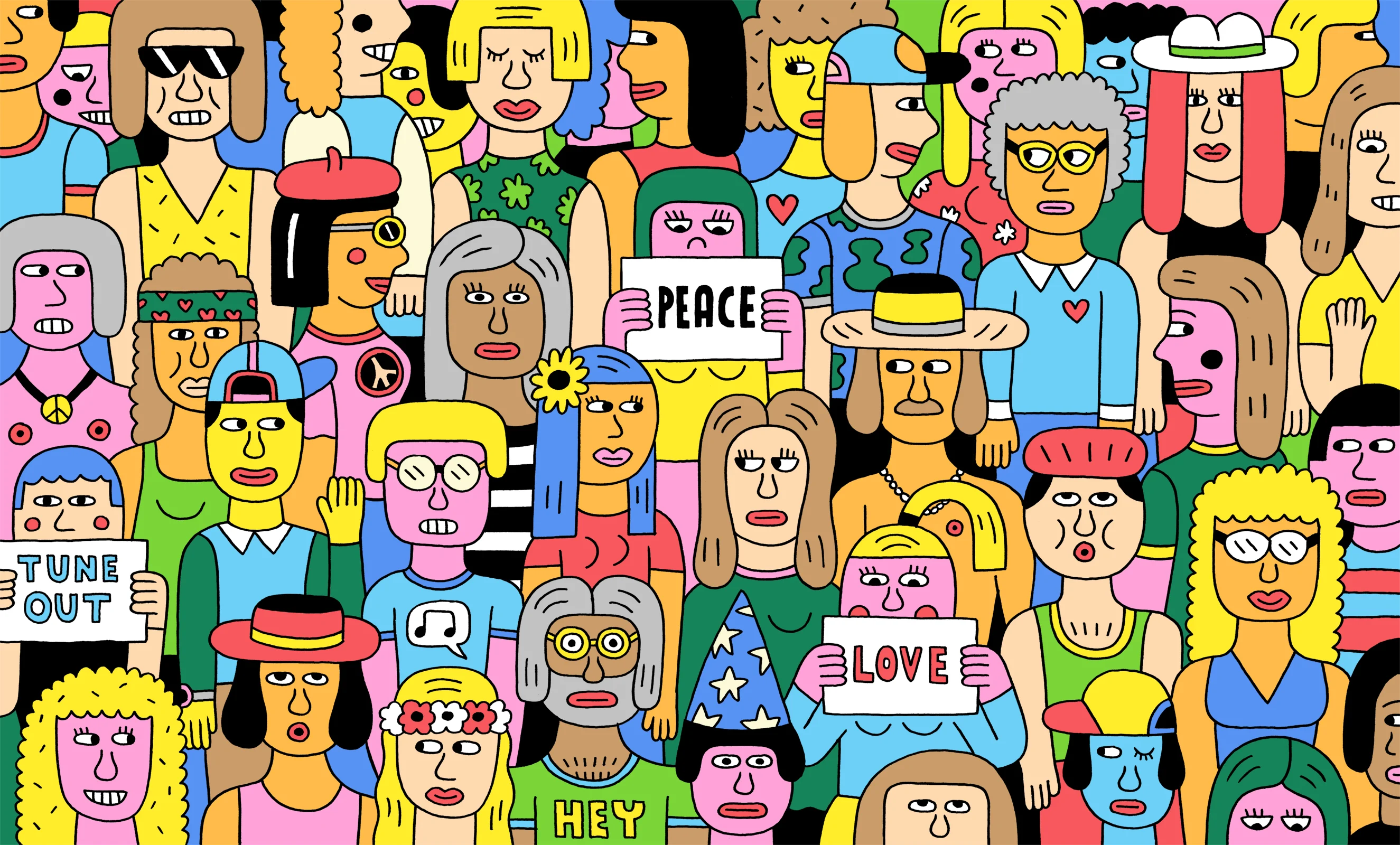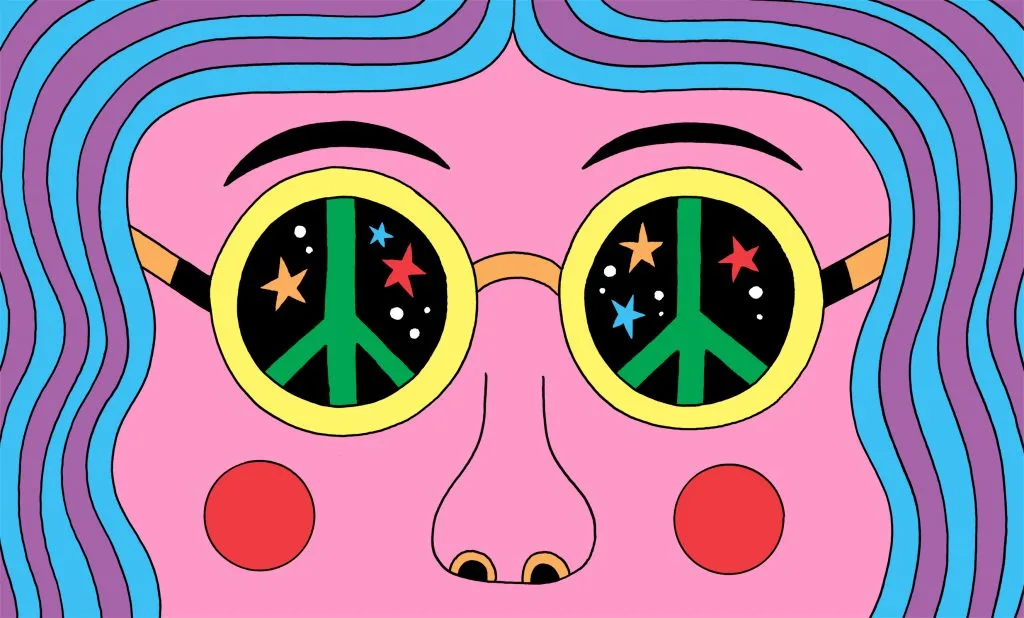

To mark the 50th anniversary of the Summer of Love in San Francisco, we commissioned Andy Rementer to create four new artworks inspired by the high water mark of hippiedom. But what was the Summer of Love? What did it mean? What did it change? And what relevance does it have today, half a century later?
Think of the Summer of Love and the visuals spring easily to mind. Flared jeans, long hair, flower power, psychedelia, peace and love. The soundtrack comes quickly too, from Janis Joplin to Jefferson Airplane.
The so-called Summer of Love happened 50 years ago this summer. In San Francisco’s Haight-Ashbury (known locally as Hashbury), hundreds of thousands kids gathered with the sense that something was happening. They believed in a new kind of future, away from suffocating conservative social norms.
Still now, that summer of 1967 has a huge cultural legacy and seems to have become part of our collective memory.
First things first – the Summer of Love was never planned. It was a spontaneous coming together of students, beatniks and drop-outs, attracted by San Francisco’s cheap housing, green spaces and ready drugs.
On 14 January 1967, the Human Be-in festival in Golden Gate Park attracted 30,000 people. By summer, the number of people who’d arrived in the city had tripled. Apparently Scott McKenzie’s lyrical call-to-arms – “Are you going to San Francisco / Be sure to wear some flowers your hair,” had struck a cord.
Growing up as a Catholic kid on Long Island in the 1960s, there had been no liberation of any sort
But reactions to the Summer of Love continue to differ. During this period, thousands of young people were crashing the neighborhood. They were often lost, penniless and homeless. There were downsides to the most-celebrated features of the hippie movement – drug addiction, disease and exploitation being the dark sides of free drugs, free love and community spirit.
Some say the hippie movement died right there, in 1967, when the media came nosing in. For others, that summer was only the beginning.
What captivated so many people to head to the Haight? Steven Palmer, a self-proclaimed “Accidental Summer-of-Love Archivist” was too young to travel to San Francisco, but was old enough to experience the vibes.
“Growing up as a Catholic kid on Long Island in the 1960s, there had been no liberation of any sort,” he explains. "People came out of the depression and experienced World War II. They wanted stability, stability, stability, and with that came a lot of conformity. Nobody was supposed to question that.
“But then one summer, my cousin came over for Thanksgiving. From one year to the next, he’d gone from decently clothed to long hair and a fringe coat. And it was as if somebody opened the window in that old 1950s house. It was like – what is that?”

My parents were hippies, and I grew up playing electric guitar, which makes it almost impossible not to be influenced by that time
The hippies wanted a clean break with what had gone before. A new sense of hope and optimism lingered in the air. This new generation challenged the status quo – people looked for spiritual guidance, banded together to tackle race issues and form women’s movements.There was an incredible sense of community (presumably enhanced by all the pot, but still).
“The simplicity, the naïveté of that time, allowed those feelings to happen,” Steven says. “There was this crackling, sparkly, cosmic, joyous, bubble.”
Andy Rementer, the artist we commissioned to celebrate the Summer of Love, worked hard to capture this spirit. “I tried to convey a sense of fun and togetherness, mixed with something surreal and slightly odd. I think that’s what this time was all about.”
Andy’s work, with its big bold colors and funky characters, isn’t too far away from the aesthetic we associate with the Summer of Love. What’s more, the American artist was raised with these ideas and ideals front and center.
“I’ve always been inspired by the 60s,” he says. “My parents were hippies, and I grew up playing electric guitar, which makes it almost impossible not to be influenced by that time.”

I think many of the things that interest us today got their start in the 60s
It was not only his parents and the music Andy fed on, but the art, the movies and the design too. “Robert Crumb is a hero of mine, and I love how he deconstructed and poked fun at the culture."
“We can take a lot of inspiration from that time,” he goes on. “There was a carefree expression of positivity and togetherness; a sense of community and caring for each other and the environment. Also, the heightened political engagement helped form a framework of thinking and political action that continues today. The hippies were so ahead of their time.”
Andy’s not the only one comparing today’s culture to that of the 1960s. Colleen Terry, co-curator of the wildly popular exhibition The Summer of Love Experience: Art, Fashion and Rock & Roll at de Young Museum in San Francisco, sees parallels as well.
“I think many of the things that interest us today got their start in the 60s,” she says. “Certainly the lives that we live would’ve been very different, had these events not taken place.
“There was the women’s movement, the environmental movement, the natural foods movement. And the idea that you need to be present and active in your government to affect change took shape at that time.”

Today’s youth does want a transformed society, but I’m not getting the sense that they’re considering major, alternative ways of living
We can see the 60s influences in today’s pop and consumer culture too. From fashion to festivals, from Emma Cline’s bestselling book The Girls to the podcast You Must Remember This’ 12-part Charles Manson special, the 60s continue to bewitch us, for better or worse.
“In terms of clothing, my co-curator Jill D’Alessandro pointed out the 60s never went out of fashion,” Colleen says. “There’s always some kind of hippie chic style in stores. And I think it’s related to the idea of a desire for a better world. It was a driving force for the counterculture movement and it’s something we draw back on today.”
Steven is also convinced that we'd live in very different times had the hippies not existed, but he’s not so sure about a revival. “I don't know if young millennials feel the hope of the Haight-Ashbury,” he says.
“I think there is a parallel to protest movements, more than there is to the hippie, drop-out kind of stuff. Today’s youth does want a transformed society, but I'm not getting the sense that they’re considering major, alternative ways of living.”
It may be true that the younger generation wants to change things by working from within the system. But maybe there is still room for a bit of 60s magic, that “crackling, sparkly, joyous bubble” which Steven describes so vividly.


